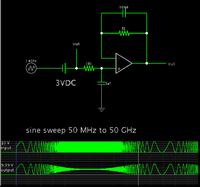knikhil271083
Member level 2

I have been told to study a design in which I have found an OP-Amp which I have been told to be working in non-inverting unity gain amplifier. But I can see that there is a 51 ohm resistor and 100pF capacitor connected in the feedback path.
Can anybody please tell me what might be the purpose of these two components in the feedback path of a unity gain amplifier. As far as I know there is no component in the feedback path of a unity gain amp. The ckt is attached herewith for reference.

Can anybody please tell me what might be the purpose of these two components in the feedback path of a unity gain amplifier. As far as I know there is no component in the feedback path of a unity gain amp. The ckt is attached herewith for reference.




